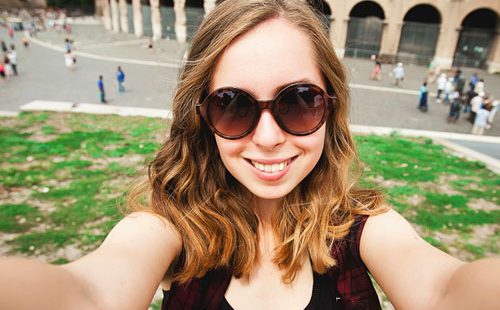As Word of the Year decisions approach, the lexicography team at Dictionary.com has been reflecting on words that have risen in popularity this year. One such word is selfie.
In case you’re unfamiliar with this term, selfie means “a photo that one takes of oneself, typically with a smartphone or webcam, especially for posting on a social-networking website.” Though self-portraits are far from a novel concept, the term selfie is relatively new, only surfacing about ten years ago in Australia. It’s a great example of classic Australian hypocoristics (for example, using “Aussie” in place of “Australian,” as discussed in this Language Log post). The precursor of the selfie is the “MySpace pic,” or a poorly lit self-portrait, often taken with the aid of a bathroom mirror and used as a profile photo on a site like MySpace (remember, this was before phones had self-facing cameras). As the ease of access to camera phones and webcams has increased, and the technology has improved, the selfie has become a mainstay on the many screens we interact with on a daily basis.
In an October 2013 New York Times piece titled “My Selfie, Myself,” Jenna Wortham reflects on the selfie trend, positing that these photos give a “human element” to primarily text-based interactions. She continues, saying that at first she was selfie-shy, but after seeing all her friends turn the camera on themselves, she followed suit. And she was rewarded: “…the occasional selfie appears to nudge some friends who I haven’t seen in a while to get in touch via e-mail or text to suggest that we meet for a drink to catch up.” By the simple act of sharing a photo of her face on a social-networking site, Wortham has noticed increased social interaction in real life.
“If you’re not in the photo, it didn’t happen.” That’s what John Shahidi, CEO of the company that released the selfie-only photo-sharing app Shots of Me (backed by pop-star Justin Bieber), told TechCrunch this week. This is not the only app on the market in which selfies play a large role. There’s also Frontback, which allows you to take simultaneous photos with both your front-facing and self-facing cameras to capture your expression as you look at something. Even Vine, which originally didn’t support shooting with the self-facing camera, found its users gravitated to this option as soon as the company added it as an update. As Kate Losse notes in the New Yorker, for social-networking sites like Instagram and SnapChat “the self is the message and the selfie is the medium.”
Since gracing the Internet, the word selfie has even had its own spinoffs. There’s the legsie, which is a selfie of legs. There are also bookshelfies, which are selfies taken in front of one’s bookshelf. Perhaps the most perverse type of selfie are funeral selfies, which are selfies taken on the way to, during or after a funeral, naturally. The fact that the word selfie has, in its short existence, already developed its own subcategories gives it the potential staying power that lexicographers look for when choosing whether or not to add a new word to the dictionary.
What do you think of this selfie phenomenon?












